Definition of Optimal Maize Seeding Rates Based on the Potential Yield of Management Zones
Abstract
:1. Introduction
2. Material and Methods
2.1. Field Characterization
2.2. Delimitation of the Management Zones
2.3. Long Strips Experiment
2.4. Data Analysis
3. Results and Discussion
3.1. Attribute Layers Analysis
3.2. Management Zones Definition
3.3. Plant Distribution
3.4. Yield Response as a Function of Seeding Density and Management Zones
4. Conclusions
Author Contributions
Funding
Institutional Review Board Statement
Informed Consent Statement
Data Availability Statement
Conflicts of Interest
References
- Sher, A.; Khan, A.; Cai, L.J.; Irfan Ahmad, M.; Asharf, U.; Jamoro, S.A. Response of Maize Grown Under High Plant Density; Performance, Issues and Management—A Critical Review. Adv. Crop Sci. Technol. 2017, 5, 275. [Google Scholar] [CrossRef] [Green Version]
- Gavioli, A.; de Souza, E.G.; Bazzi, C.L.; Schenatto, K.; Betzek, N.M. Identification of management zones in precision agriculture: An evaluation of alternative cluster analysis methods. Biosyst. Eng. 2019, 181, 86–102. [Google Scholar] [CrossRef]
- Molin, J.P.; Bazame, H.C.; Maldaner, L.; Corredo, L.d.P.; Martello, M.; Canata, T.F. Precision agriculture and the digital contributions for site-specific management of the fields. Rev. CIÊNCIA AGRONÔMICA 2020, 51, 1–10. [Google Scholar] [CrossRef]
- Munnaf, M.A.; Haesaert, G.; Van Meirvenne, M.; Mouazen, A.M. Site-specific seeding using multi-sensor and data fusion techniques: A review. In Advances in Agronomy; Academic Press Inc.: Cambridge, MA, USA, 2020; Volume 161, pp. 241–323. ISBN 9780128207659. [Google Scholar]
- da Silva, E.E.; Baio, F.H.R.; Teodoro, L.P.R.; Campos, C.N.S.; Plaster, O.B.; Teodoro, P.E. Variable-rate seeding in soybean according to soil attributes related to grain yield. Precis. Agric. 2021, 1–17. [Google Scholar] [CrossRef]
- Licht, M.A.; Lenssen, A.W.; Elmore, R.W. Corn (Zea mays L.) seeding rate optimization in Iowa, USA. Precis. Agric. 2017, 18, 452–469. [Google Scholar] [CrossRef] [Green Version]
- Coronel, E.G.; Alesso, C.A.; Bollero, G.A.; Armstrong, K.L.; Martin, N.F. Field-specific yield response to variable seeding depth of corn in the Midwest. Agrosystems Geosci. Environ. 2020, 3, e20034. [Google Scholar] [CrossRef]
- Chen, S.; Du, T.; Wang, S.; Parsons, D.; Wu, D.; Guo, X.; Li, D. Quantifying the effects of spatial-temporal variability of soil properties on crop growth in management zones within an irrigated maize field in Northwest China. Agric. Water Manag. 2021, 244, 106535. [Google Scholar] [CrossRef]
- Rodrigues, M.S.; Corá, J.E. Management zones using fuzzy clustering based on spatial-temporal variability of soil and corn yield. Eng. Agric. 2015, 35, 470–483. [Google Scholar] [CrossRef] [Green Version]
- Oldoni, H.; Silva Terra, V.S.; Timm, L.C.; Júnior, C.R.; Monteiro, A.B. Delineation of management zones in a peach orchard using multivariate and geostatistical analyses. Soil Tillage Res. 2019, 191, 1–10. [Google Scholar] [CrossRef]
- Breunig, F.M.; Galvão, L.S.; Dalagnol, R.; Santi, A.L.; Della Flora, D.P.; Chen, S. Assessing the effect of spatial resolution on the delineation of management zones for smallholder farming in southern Brazil. Remote Sens. Appl. Soc. Environ. 2020, 19, 100325. [Google Scholar] [CrossRef]
- Breunig, F.M.; Galvão, L.S.; Dalagnol, R.; Dauve, C.E.; Parraga, A.; Santi, A.L.; Della Flora, D.P.; Chen, S. Delineation of management zones in agricultural fields using cover–crop biomass estimates from PlanetScope data. Int. J. Appl. Earth Obs. Geoinf. 2020, 85, 102004. [Google Scholar] [CrossRef]
- Cordero, E.; Longchamps, L.; Khosla, R.; Sacco, D. Joint measurements of NDVI and crop production data-set related to combination of management zones delineation and nitrogen fertilisation levels. Data Br. 2020, 28, 104968. [Google Scholar] [CrossRef]
- Arshad, M.; Li, N.; Zhao, D.; Sefton, M.; Triantafilis, J. Comparing management zone maps to address infertility and sodicity in sugarcane fields. Soil Tillage Res. 2019, 193, 122–132. [Google Scholar] [CrossRef]
- Méndez-Vázquez, L.J.; Lira-Noriega, A.; Lasa-Covarrubias, R.; Cerdeira-Estrada, S. Delineation of site-specific management zones for pest control purposes: Exploring precision agriculture and species distribution modeling approaches. Comput. Electron. Agric. 2019, 167, 105101. [Google Scholar] [CrossRef]
- Kayad, A.; Sozzi, M.; Gatto, S.; Whelan, B.; Sartori, L.; Marinello, F. Ten years of corn yield dynamics at field scale under digital agriculture solutions: A case study from North Italy. Comput. Electron. Agric. 2021, 185, 106126. [Google Scholar] [CrossRef]
- Miao, Y.; Mulla, D.J.; Robert, P.C. An integrated approach to site-specific management zone delineation. Front. Agric. Sci. Eng. 2018, 5, 432–441. [Google Scholar] [CrossRef] [Green Version]
- Paccioretti, P.; Córdoba, M.; Balzarini, M. FastMapping: Software to create field maps and identify management zones in precision agriculture. Comput. Electron. Agric. 2020, 175, 105556. [Google Scholar] [CrossRef]
- Hörbe, T.A.N.; Amado, T.J.C.; Ferreira, A.O.; Alba, P.J. Optimization of corn plant population according to management zones in Southern Brazil. Precis. Agric. 2013, 14, 450–465. [Google Scholar] [CrossRef]
- Li, J.; Xie, R.Z.; Wang, K.R.; Ming, B.; Guo, Y.Q.; Zhang, G.Q.; Li, S.K. Variations in maize dry matter, harvest index, and grain yield with plant density. Agron. J. 2015, 107, 829–834. [Google Scholar] [CrossRef]
- Schenatto, K.; de Souza, E.G.; Bazzi, C.L.; Gavioli, A.; Betzek, N.M.; Beneduzzi, H.M. Normalization of data for delineating management zones. Comput. Electron. Agric. 2017, 143, 238–248. [Google Scholar] [CrossRef]
- Spekken, M.; Anselmi, A.A.; Molin, J.P. A simple method for filtering spatial data. In Proceedings of the Precision Agriculture 2013, Proceedings of the 9th European Conference on Precision Agriculture, ECPA 2013; Wageningen Academic Publishers: Wageningen, The Netherlands, 2013; pp. 259–266. [Google Scholar]
- R Core Team. A Language and Environment for Statistical Computing; R Core Team: Vienna, Austria, 2021. [Google Scholar]
- Wang, X.X.; Liu, S.; Zhang, S.; Li, H.; Maimaitiaili, B.; Feng, G.; Rengel, Z. Localized ammonium and phosphorus fertilization can improve cotton lint yield by decreasing rhizosphere soil pH and salinity. F. Crop. Res. 2018, 217, 75–81. [Google Scholar] [CrossRef]
- Molin, J.P.; Rabello, L.M. Estudo sobre a mensuração da condutividade elétrica do solo. Eng. Agrícola 2011, 31, 90–101. [Google Scholar] [CrossRef]
- Uribeetxebarria, A.; Arnó, J.; Escolà, A.; Martínez-Casasnovas, J.A. Apparent electrical conductivity and multivariate analysis of soil properties to assess soil constraints in orchards affected by previous parcelling. Geoderma 2018, 319, 185–193. [Google Scholar] [CrossRef] [Green Version]
- Albornoz, V.M.; Ñanco, L.J.; Sáez, J.L. Delineating robust rectangular management zones based on column generation algorithm. Comput. Electron. Agric. 2019, 161, 194–201. [Google Scholar] [CrossRef]
- Umbelino, A.D.S.; De Oliveira, D.G.; Martins, M.P.D.O.; Reis, E.F. Dos Definições de zona de manejo para soja de alta produtividade. Rev. Ciências Agrárias 2018, 41, 674–682. [Google Scholar] [CrossRef]
- Sangoi, L.; Schmitt, A.; Vieira, J.; José Picoli, G.J.; Arruda Souza, C.; Trezzi Casa, R.; Eduardo Schenatto, D.; Giordani, W.; Majolo Boniatti, C.; Cardoso Machado, G.; et al. Revista Brasileira de Milho e Sorgo; Associação Brasileira de Milho e Sorgo: Sete Lagoas, Brazil, 2013; ISSN 1676-689X. [Google Scholar]
- Kolling, D.F.; Sangoi, L.; de Souza, C.A.; Schenatto, D.E.; Giordani, W.; Boniatti, C.M. Tratamento de sementes com bioestimulante ao milho submetido a diferentes variabilidades na distribuição espacial das plantas. Cienc. Rural 2016, 46, 248–253. [Google Scholar] [CrossRef] [Green Version]
- Barman, A.; Sheoran, P.; Yadav, R.K.; Abhishek, R.; Sharma, R.; Prajapat, K.; Singh, R.K.; Kumar, S. Soil spatial variability characterization: Delineating index-based management zones in salt-affected agroecosystem of India. J. Environ. Manag. 2021, 296, 113243. [Google Scholar] [CrossRef]
- Cid-Garcia, N.M.; Ibarra-Rojas, O.J. An integrated approach for the rectangular delineation of management zones and the crop planning problems. Comput. Electron. Agric. 2019, 164, 104925. [Google Scholar] [CrossRef]

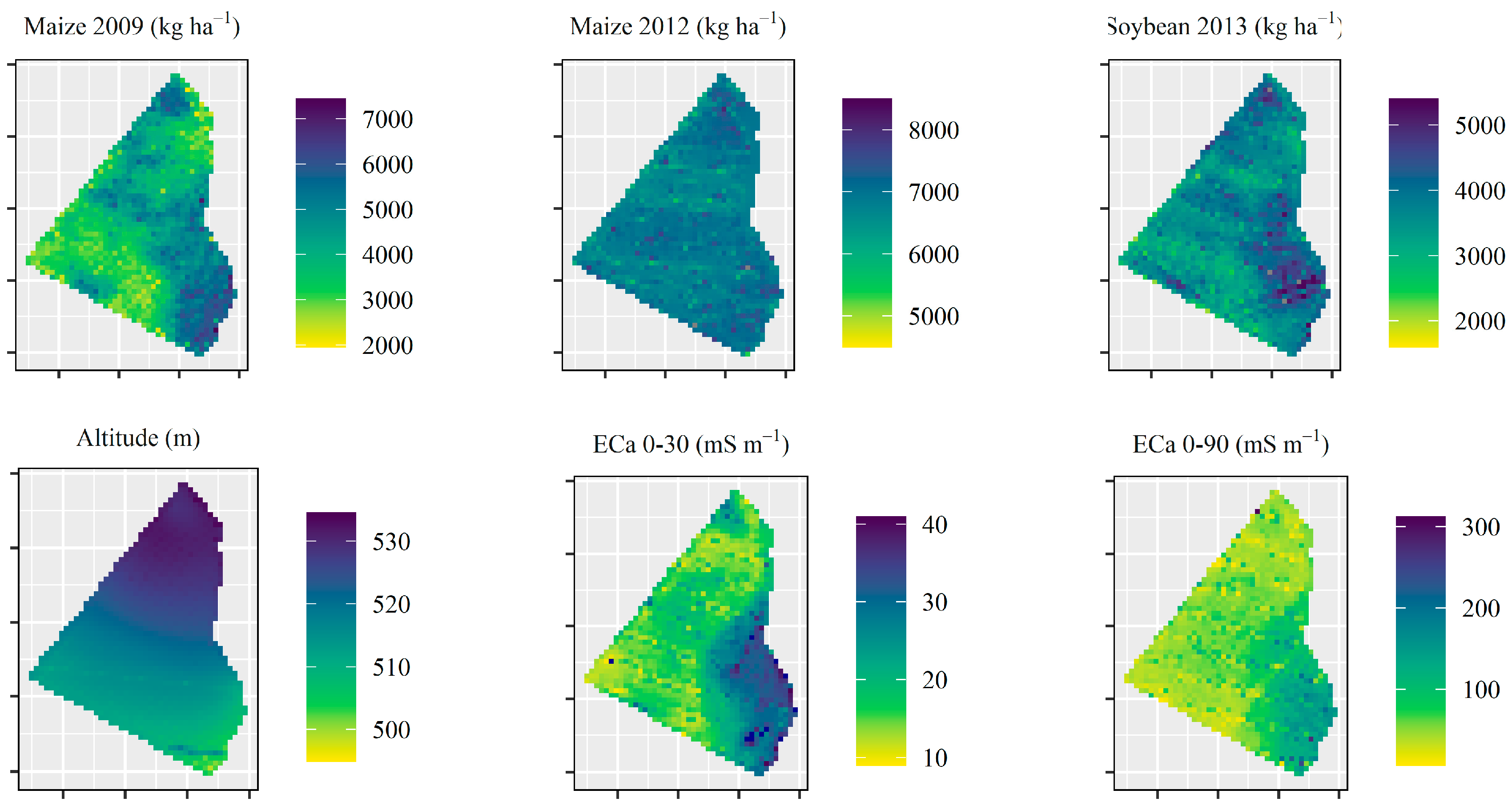
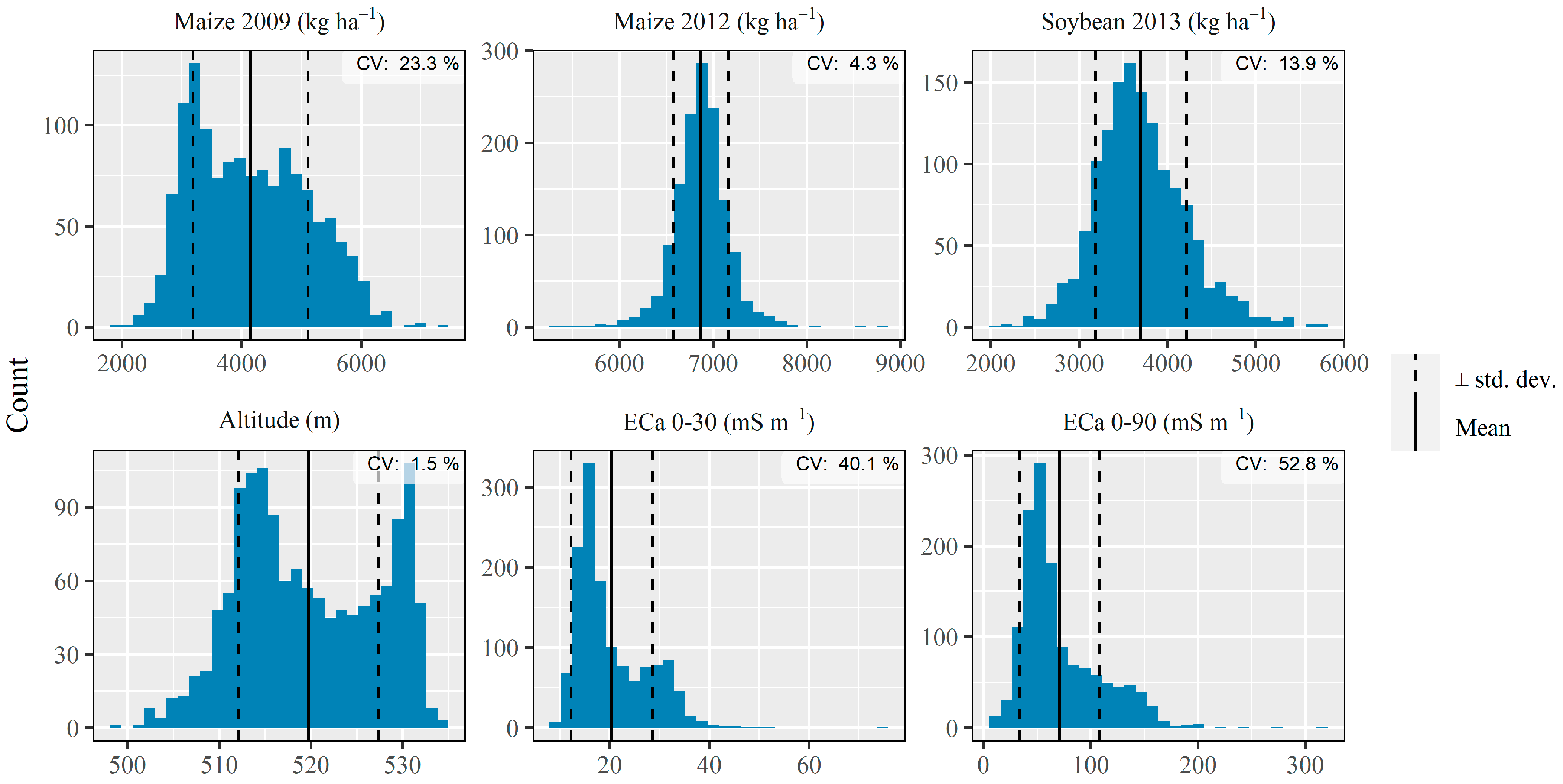
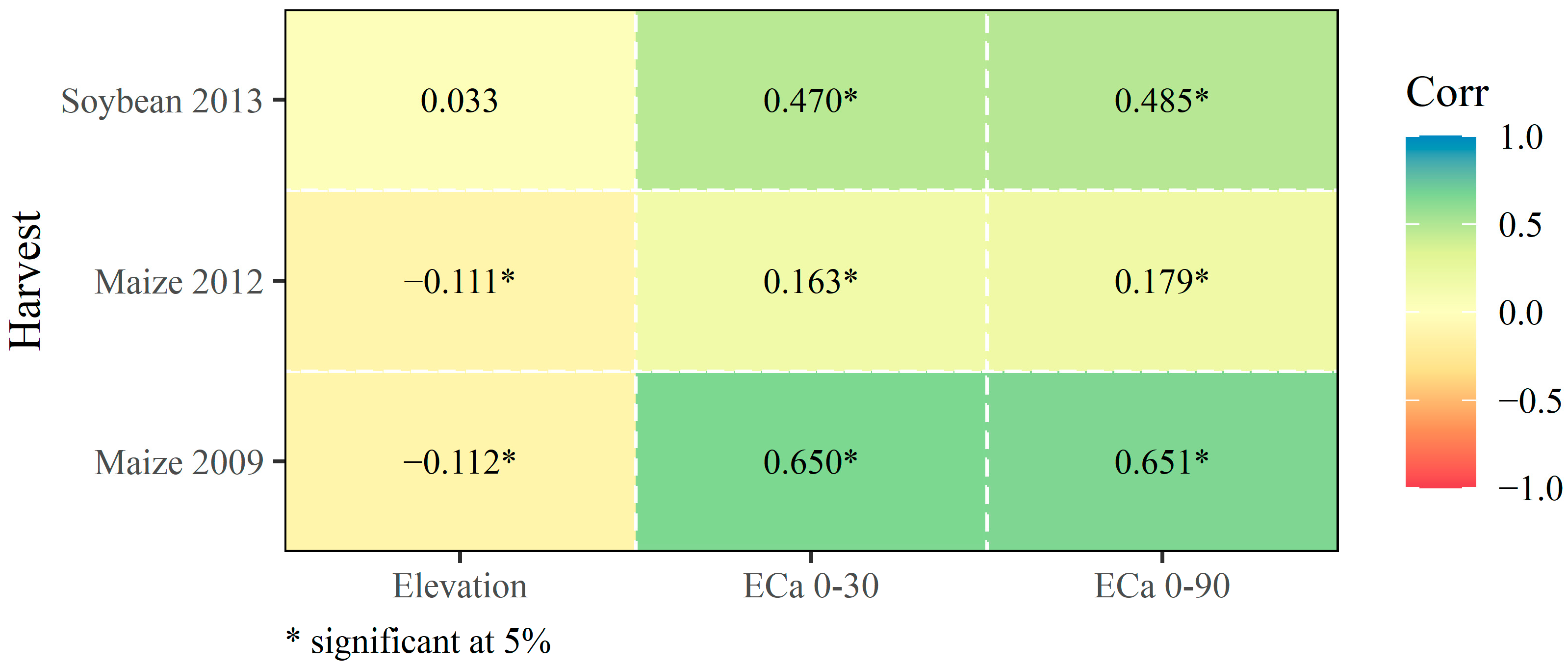
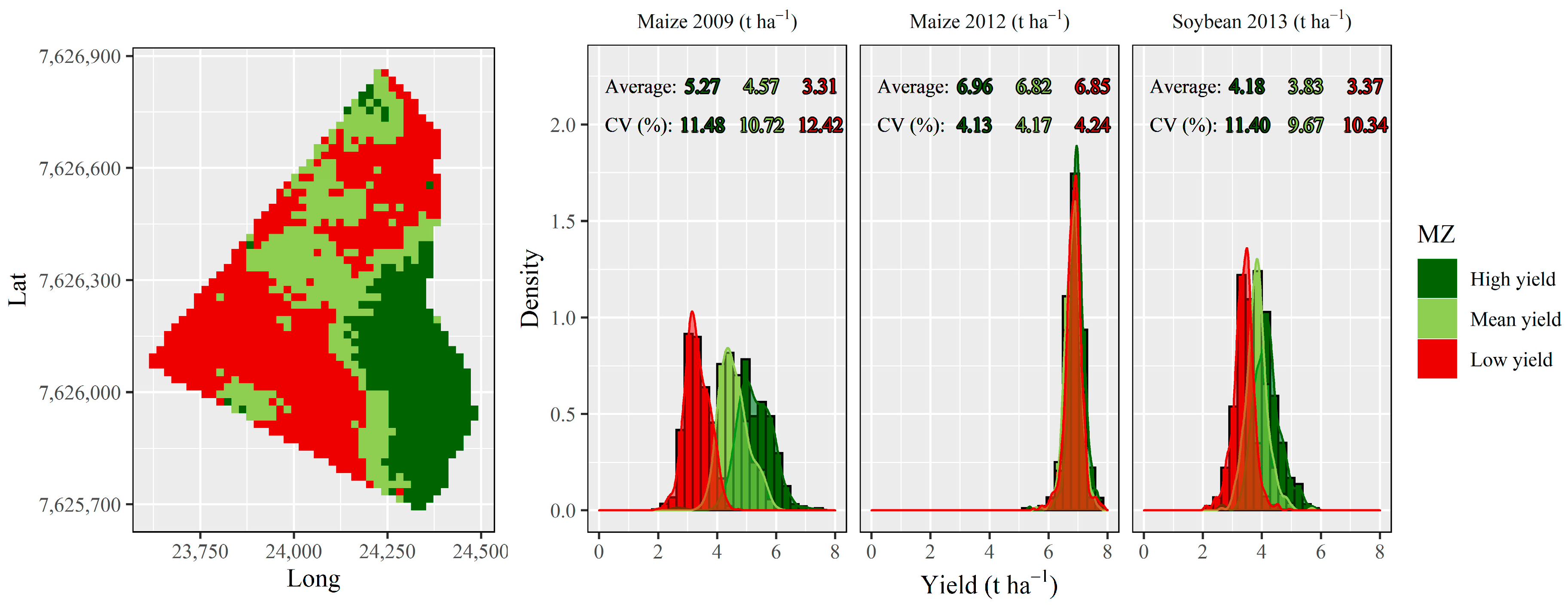
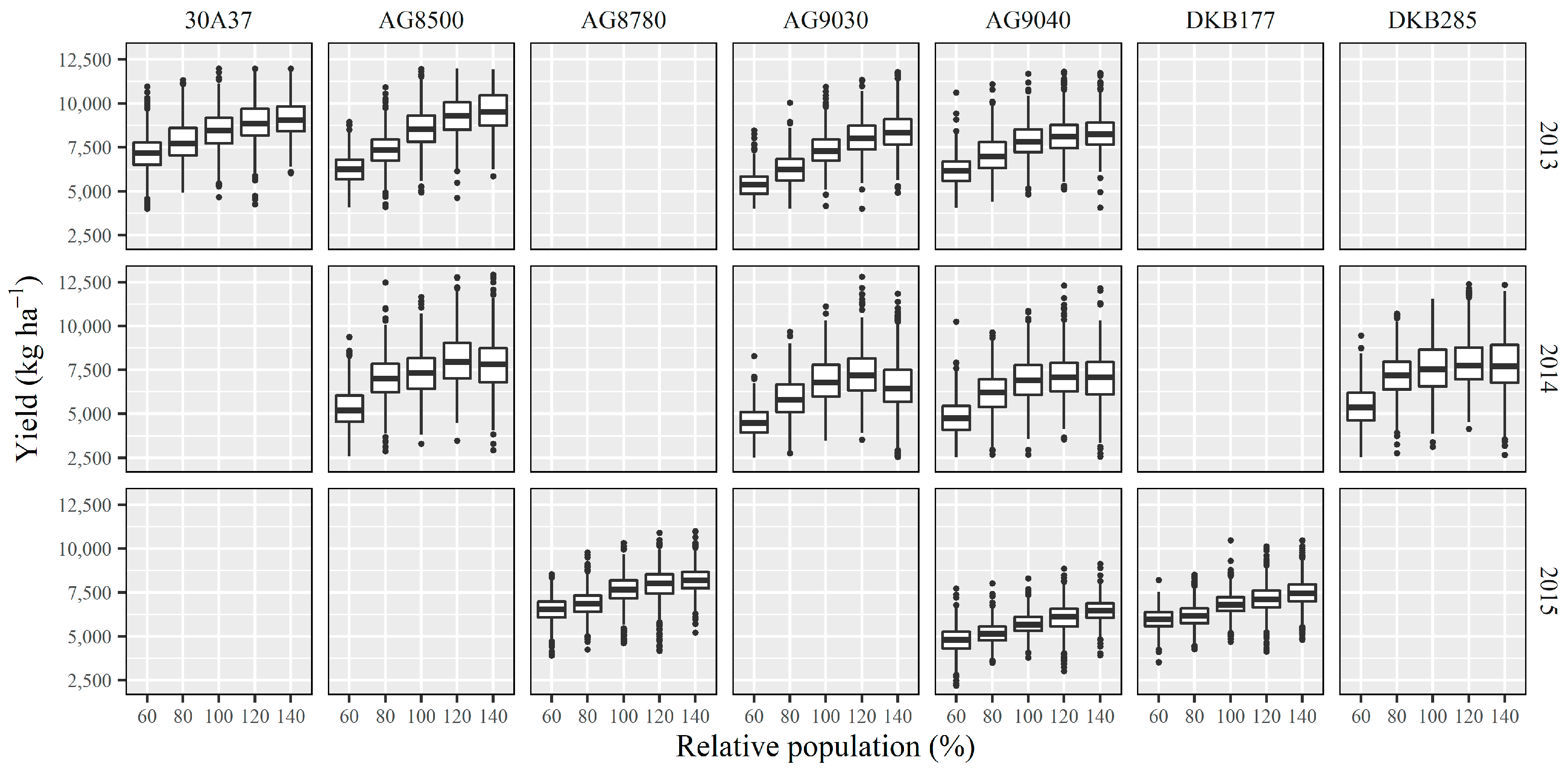



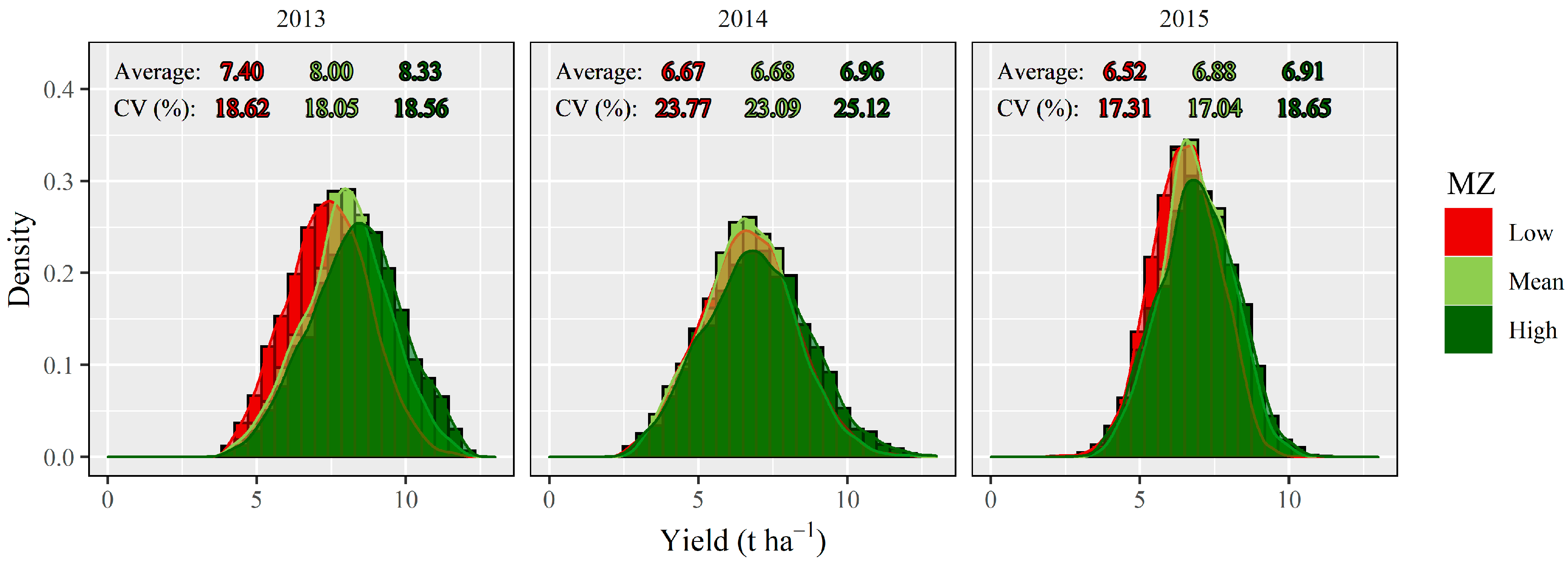
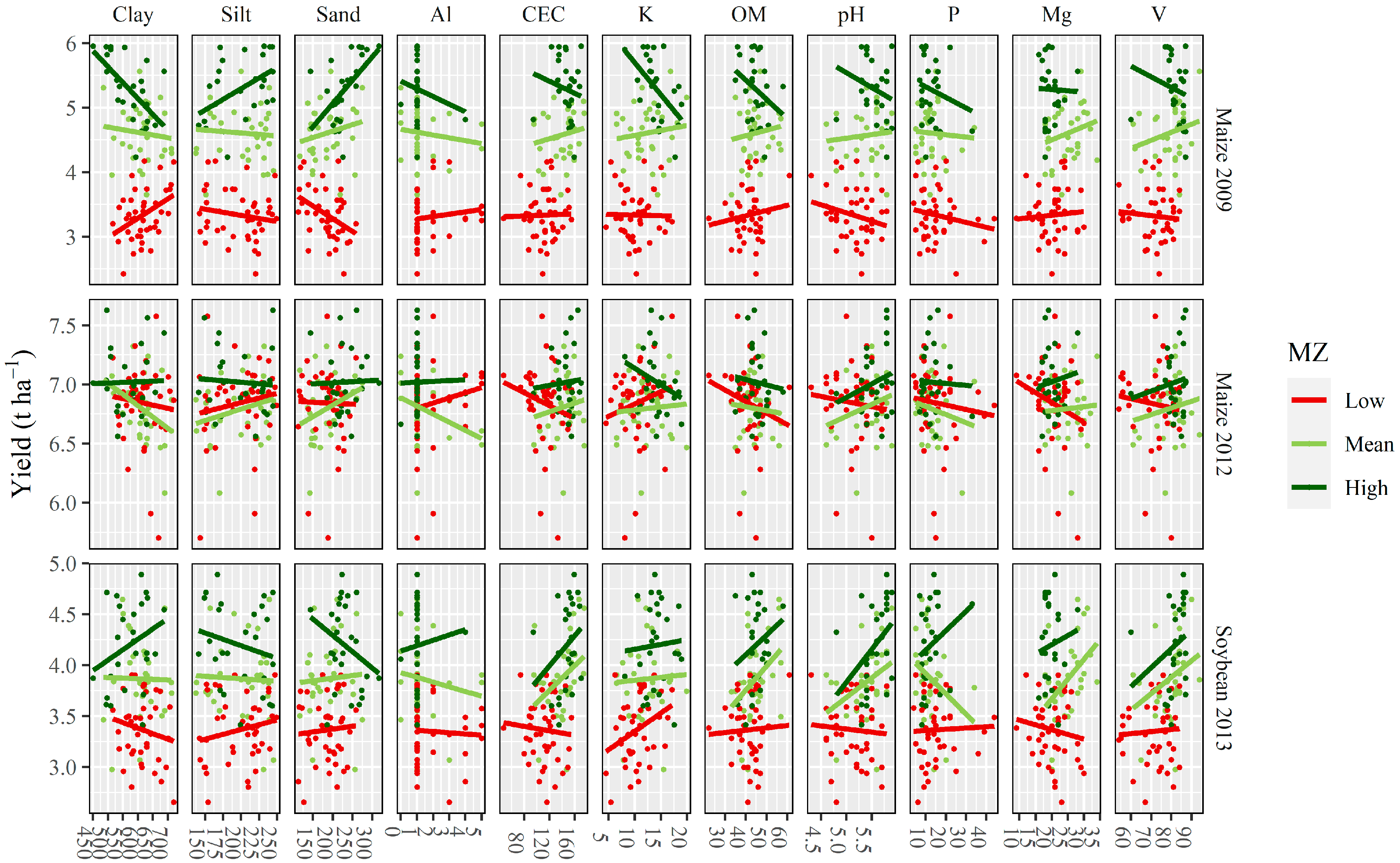
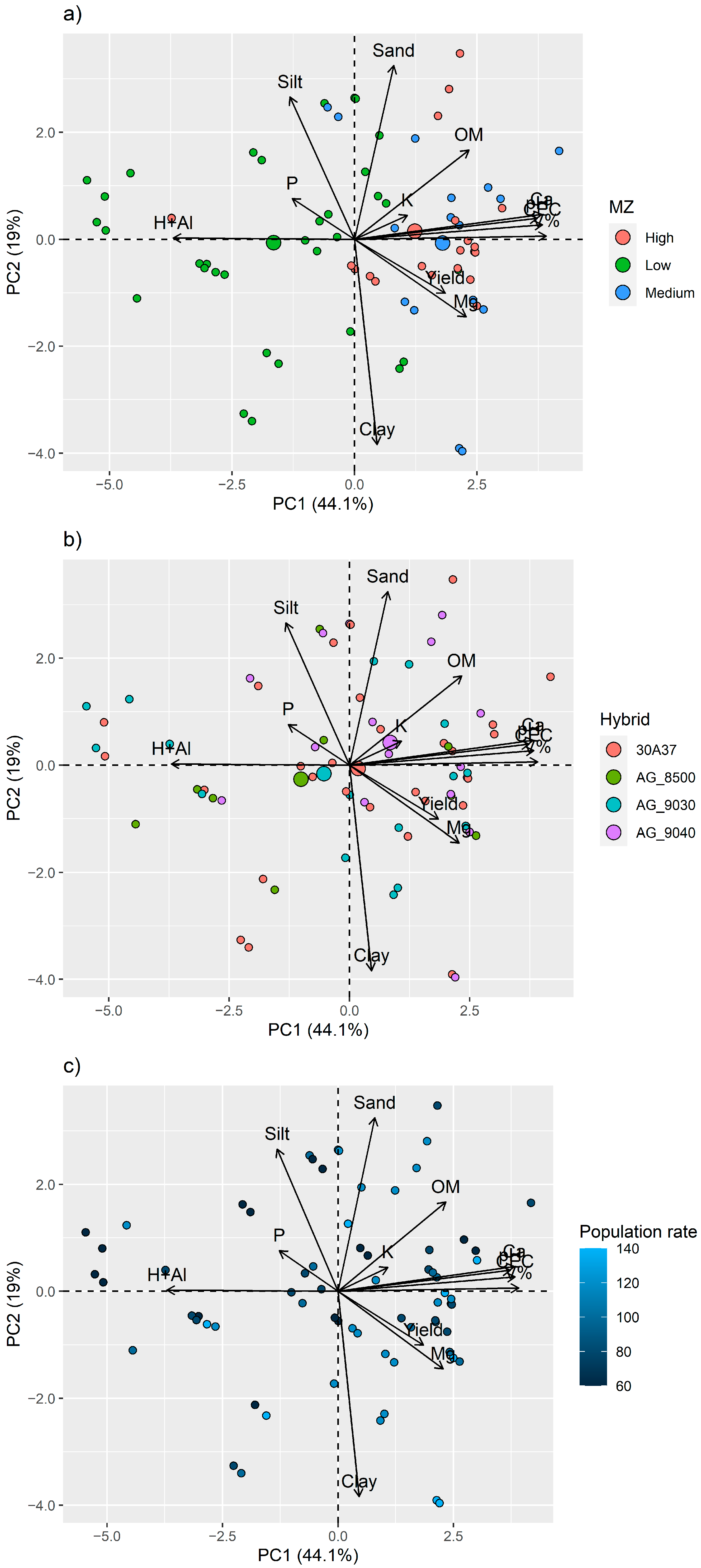
| Hybrid | Seed Company | Growing Degree Days | Recommended Seeding Density (plants ha−1) |
|---|---|---|---|
| AG 8500 | Sementes Agroceres | 860 | 50,000–55,000 |
| AG 9030 | Sementes Agroceres | 795 | 55,000–65,000 |
| AG 9040 | Sementes Agroceres | 790 | 55,000–60,000 |
| AG 8780 | Sementes Agroceres | 820 | 50,000–55,000 |
| DKB 177 | Dekalb | 860 | 55,000–65,000 |
| DKB 285 | Dekalb | 795 | 50,000–60,000 |
| 30A37 | Morgan Sementes | 810 | 50,000–60,000 |
| Management Zones-Yield Potential | ||||
|---|---|---|---|---|
| Var | Low | Mean | High | p-Value |
| Al (mmolc dm−3) | 2.42 (2.58) ¹ | 1.32 (1.19) | 1.08 (0.63) | 0.00635 * |
| Sand (g/kg) | 185.98 (37.49) | 184.74 (42.48) | 230.23 (36.37) | <0.0001 * |
| Clay (g/kg) | 616.05 (50.33) | 613.00 (55.52) | 571.85 (59.61) | 0.00348 * |
| Silt (g/kg) | 198.00 (32.60) | 202.10 (34.71) | 198.04 (34.70) | 0.85585 |
| Effective CEC (mmolc dm−3) | 111.44 (22.25) | 141.42 (26.74) | 147.27 (15.85) | <0.0001 * |
| K (mmolc/dm3) | 10.41 (2.89) | 12.27 (3.42) | 14.16 (2.59) | <0.0001 * |
| Organic matter (g dm−3) | 41.21 (6.34) | 44.71 (6.34) | 44.88 (4.97) | 0.0156 |
| pH CaCl2 | 5.14 (0.36) | 5.49 (0.45) | 5.56 (0.25) | <0.0001 * |
| P (mg dm−3) | 15.16 (8.73) | 12.61 (6.31) | 12.50 (5.56) | 0.21583 |
| Mg (mmolc dm−3) | 20.21 (4.65) | 25.03 (4.52) | 19.69 (2.54) | <0.0001 * |
| V (%) | 70.30 (10.17) | 79.03 (7.91) | 81.92 (5.53) | <0.0001 * |
| ECa 0–0.30 m (mS m−1) | 14.24 (5.06) | 19.59 (7.39) | 33.38 (19.67) | <0.0001 * |
| ECa 0–0.90 m (mS m−1) | 46.84 (43.86) | 62.23 (55.27) | 128.50 (87.81) | <0.0001 * |
| Relative Plant Population (%) | 60 | 80 | 100 | 120 | 140 | Mean |
|---|---|---|---|---|---|---|
| 2013 | ||||||
| Skips (%) | 5 | 6 | 6 | 7 | 10 | 7 |
| Multiple (%) | 3 | 4 | 5 | 6 | 7 | 5 |
| Acceptable (%) | 93 | 89 | 89 | 87 | 83 | 88 |
| CV (%) | 30 | 32 | 37 | 36 | 46 | 36 |
| N | 1296 | 1296 | 1296 | 1296 | 1296 | 1296 |
| 2014 | ||||||
| Skips (%) | 6 | 7 | 10 | 9 | 13 | 9 |
| Multiple (%) | 4 | 6 | 6 | 5 | 9 | 6 |
| Acceptable (%) | 90 | 86 | 83 | 86 | 78 | 85 |
| CV (%) | 33 | 38 | 41 | 38 | 44 | 39 |
| N | 870 | 870 | 870 | 870 | 870 | 870 |
| 2015 | ||||||
| Skips (%) | 9 | 10 | 11 | 11 | 14 | 11 |
| Multiple (%) | 3 | 4 | 4 | 4 | 4 | 4 |
| Acceptable (%) | 88 | 86 | 85 | 85 | 82 | 85 |
| CV (%) | 33 | 37 | 41 | 41 | 46 | 40 |
| N | 580 | 580 | 580 | 580 | 580 | 580 |
Publisher’s Note: MDPI stays neutral with regard to jurisdictional claims in published maps and institutional affiliations. |
© 2021 by the authors. Licensee MDPI, Basel, Switzerland. This article is an open access article distributed under the terms and conditions of the Creative Commons Attribution (CC BY) license (https://creativecommons.org/licenses/by/4.0/).
Share and Cite
Anselmi, A.A.; Molin, J.P.; Bazame, H.C.; Corrêdo, L.d.P. Definition of Optimal Maize Seeding Rates Based on the Potential Yield of Management Zones. Agriculture 2021, 11, 911. https://doi.org/10.3390/agriculture11100911
Anselmi AA, Molin JP, Bazame HC, Corrêdo LdP. Definition of Optimal Maize Seeding Rates Based on the Potential Yield of Management Zones. Agriculture. 2021; 11(10):911. https://doi.org/10.3390/agriculture11100911
Chicago/Turabian StyleAnselmi, Adriano Adelcino, José Paulo Molin, Helizani Couto Bazame, and Lucas de Paula Corrêdo. 2021. "Definition of Optimal Maize Seeding Rates Based on the Potential Yield of Management Zones" Agriculture 11, no. 10: 911. https://doi.org/10.3390/agriculture11100911
APA StyleAnselmi, A. A., Molin, J. P., Bazame, H. C., & Corrêdo, L. d. P. (2021). Definition of Optimal Maize Seeding Rates Based on the Potential Yield of Management Zones. Agriculture, 11(10), 911. https://doi.org/10.3390/agriculture11100911









